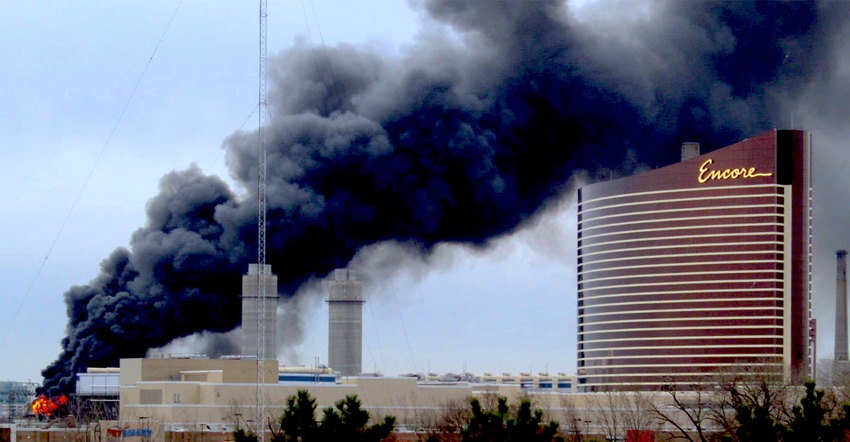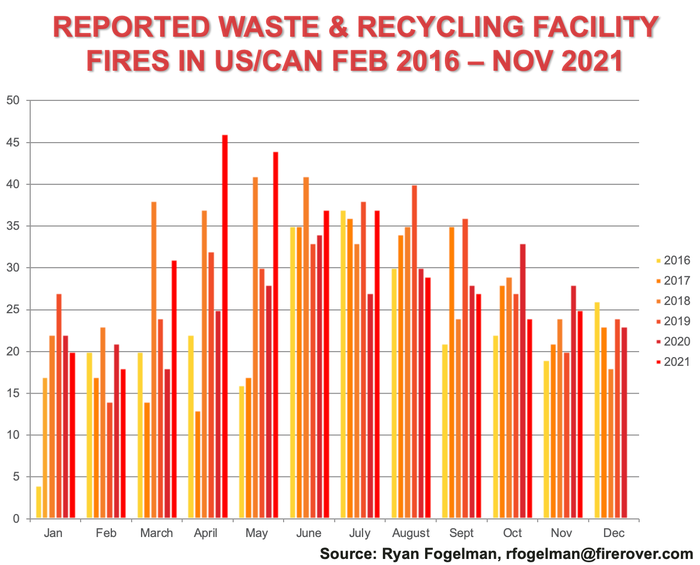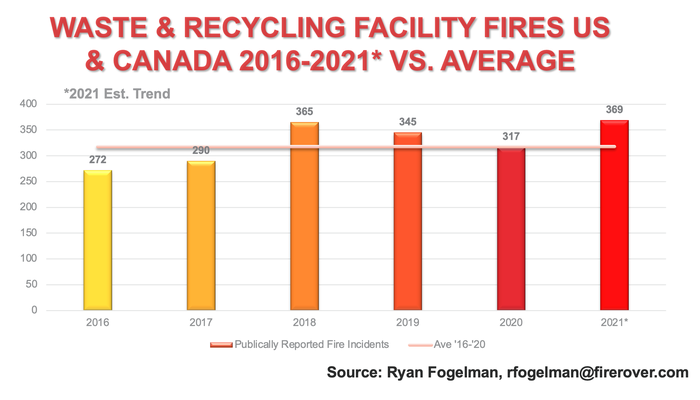
You’ve heard me say many times that insurance companies are running from the waste and recycling industry, but I recently connected with an insurer who understands our industry and risks because his company has taken the time to truly know each client and their day-to-day operations.
In this month’s column, I highlight November’s 2021 fire data and sit down with Stuart Kinsella of Rokstone Underwriting to discuss how his company is bucking the global insurance trend.
November 2021 Fire Data
In November, we encountered 25 reported fire incidents at our waste and recycling facilities in the U.S. and Canada. Of these reported incidents, 11 occurred at scrap metal operations, 10 occurred at waste, paper and plastic operations, three occurred at construction and demolition (C&D) operations and one occurred at a rubber facility. At Fire Rover’s 250-plus client operations, we responded to 73 fire incidents in November to go along with the 69 fire incidents in October, 69 in September, 92 in August, 88 in July, 77 in June, 88 in May and 74 in April. This October, we experienced the second-highest number of fire incidents in November when compared with historically reported waste and recycling facility fires in the U.S. and Canada.

The good news on an annual basis is that 2021 is inching back toward our historical high we experienced in 2018. Unfortunately, we are still on pace for 2021 to be the worst year for publicly reported fire incidents since I began tracking these fires in 2016. I can assure you that I have my eye on these incidents and look forward to the end of the year where I consolidate the 2021 data and insight for the next “Waste & Recycling Facility Fires Annual Report.” Click here to reserve your advanced copy of this year’s annual waste and recycling facility fire report.

With Insurance Companies Tightening Their Risk Profiles, Who You Gonna Call?
I believe most folks in our industry based in the U.S. would agree that securing property insurance at waste and recycling facilities has been getting progressively more difficult over the past five years. The tightening of risk is not just occurring in North America but globally. As I have been launching our Fire Rover solution in Canada, Australia and the UK, I have seen this contraction of options affect most countries across the globe.
Last month, I was fortunate to present at the Fire Prevention & Control in the Waste & Recycling Industry Workshop held in Birmingham, England. In attendance were some of the best and brightest in the waste and recycling industry in and around the UK. If you have been following my research and reporting, I have been overly impressed with the level of insight the UK has provided to its fire incident reporting for decades. In my opinion, I believe this is because it is easier to get all of the players in one room as well as strong leadership from the Environment Agency, the UK’s version of the U.S. Environmental Protection Agency (EPA), leading the charge.
Could you imagine trying to corral the right players from industry, manufacturers, associations, government, fire professionals, insurers and more in one room? Then let’s try to build a consensus on the best practices moving forward. I do not say that as a slight but as a reality we deal with when our population is six times the size of the UK. In the U.S., the EPA recently dipped its toe in the water by releasing its first analysis of the fire issues our waste and recycling operators are facing. These issues are real, and I believe that we need government to intervene and hold the battery manufacturers responsible for the hazards their products are causing in our waste and recycling streams. But, until that time comes, we will leave it to market forces to deal with the issues and leave our waste and recycling operators limited choices in securing insurance through less coverage, larger deductibles, self-insurance (if in the position), higher premiums and layering of coverage.
During my visit to the UK, I met Stuart “Who You Gunna Call” Kinsella, who happens to provide insurance options to the waste and recycling occupancies across the UK, U.S. and Australia. I nicknamed him after the Ghostbusters slogan because as traditional insurers continue to pull out of our industry, Kinsella’s company, Rokstone Underwriting, is bucking the trend across the globe.
Ryan Fogelman: From an insurance perspective, why is the market so tight?
Stuart Kinsella: For too long, the insurance providers within the waste and recycling arena have been writing business with inadequate pricing and inadequate risk management, particularly risk management that isn’t proportionate to the risk presented. At Rokstone Underwriting, we have been involved in the industry for more than 25 years, and the team exclusively writes this class of business globally. As a result, we have developed and refined a process that is market leading, which looks at each risk in a multifaceted way—from understanding material types, process types, storage arrangements and which risk management tools are most capable of dealing with the varying risks. We believe that recycling risks are not homogenous, and each requires an in-depth understanding. Through gaining this, we have built a robust program to cater to all ends of the hazard spectrum in the industry—from metal recyclers to alternative fuel production and everything in between.
Ryan Fogelman: Why are you willing to insure in these occupancies when others are pulling out?
Stuart Kinsella: It’s simple. We understand the class better than our competitors. We understand the difference between C&D recyclers and commercial and industrial (C&I) recyclers, and we understand the precise risk management tools that are most effective for policyholders. We spend time with our policyholders surveying the sites each year. As the market develops quickly, so do risk management techniques, which can often differ over a 12-month period. So, we capture that window each year with specialist risk engineers who are dedicated exclusively to our policyholders globally.
Ryan Fogelman: What is your best advice for risk mitigation at waste and recycling facilities?
Stuart Kinsella: The best advice is to avoid a fire altogether rather than relying on mitigation measures once one has occurred. We do this by pragmatically working through viable options with the client. As previously mentioned, these risks are not the same—each poses a different hazard, and each can react differently to policy conditions. We have standard conditions around storage proximity and quantity, which are not always workable for a client. However, we tailor our offering for those who cannot accommodate standard conditions to benefit all parties.
Coupled with the above, our risk engineers work closely with all insured parties. This involves thinking outside of the box in all aspects of the operation, such as site layout and storage management. Simply rotating a storage bay of combustible material can greatly reduce financial loss in the event of an incident occurring with little to no cost to the client. We also look to install the correct type of detection and suppression systems for the risk. Early detection methods linked with monitoring stations and installation of suppression systems that are fit for purpose are key in reducing exposure and ultimately enticing the insurance market to provide terms.
Ryan Fogelman: What makes your solution unique to others in the market?
Stuart Kinsella: It’s sustainable. Whilst the U.S. is a relatively new footprint for us, recycling is not. We are specialists in this class, and our solution is unique in our understanding. We do not write general property business; we exclusively write for the waste and recycling business. It’s all we see, day in and day out. We have a unique proposal form that gets into detail far more than our competitors, and the net result of that is we have a sustainable solution where brokers and policyholders alike can rely on us in what has historically been a volatile market.
Conclusion
I think Kinsella’s approach is refreshing, especially since we need as many solid insurance options for our operators as we can get. Insurers are starting to get more comfortable with our industry on a client-by-client basis, and it’s our job to educate them about our industry so they fully understand the inner workings of our operations.
The days of operators having a hands-off approach to insurance providers are evolving into insurance providers wanting to understand the general industry risks and trends, as well as each operators’ unique operations, risk profile and the tools they are using to mitigate their risk.
As Kinsella outlined above, the issue is that we have so many different types of operations that fall under the waste and recycling label, such as e-cycling, waste, paper, plastics, C&D, metal recycling and more. Think about the unique risks that each of those different operators face.
As the year comes to a close, we are still on track to have the highest number of reported fire incidents since I began reporting these numbers in 2016. In 2018, we experienced a surge in lithium-ion batteries entering our waste and recycling streams, and now, three years later, I think we can all agree that the battery-specific hazards are only going to get worse. So, we need to double down and focus on operational best practices, education and technology to make a dent in the wave of hazards we will continue to see. Additionally, we need healthy waste and recycling infrastructure not only for sanitary reasons but to meet the growing demand for green initiatives. It’s going to take all of us to turn these issues around, so let’s start 2022 off right by coming together to work more safely and efficiently.
Ryan Fogelman, JD/MBA, is vice president of strategic partnerships for Fire Rover. He is focused on bringing innovative safety solutions to market, and two of his solutions have won the distinguished Edison Innovation Award for Industrial Safety and Consumer Products. He has been compiling and publishing the “Reported Waste & Recycling Facility Fires In The US/CAN” since February 2016 and the “Waste & Recycling Facility Fires Annual Report.” Fogelman speaks regularly on the topic of the scope of fire problems facing the waste and recycling industries, detection solutions, proper fire planning and early-stage fire risk mitigation. Additionally, Fogelman is on the National Fire Protection Association’s Technical Committee for Hazard Materials. (Connect with Ryan on LinkedIn at https://www.linkedin.com/in/ryanjayfogelman or email at [email protected])
About the Author(s)
You May Also Like




